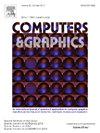用于非线性粗糙2D动画的遮挡
IF 2.5
4区 计算机科学
Q2 COMPUTER SCIENCE, SOFTWARE ENGINEERING
引用次数: 0
摘要
通过2D动画绘图表示3D运动和深度是一项非常困难的任务,手工完成时需要时间和专业知识。艺术家必须特别注意闭塞,以及它们如何随着时间的推移而演变,这是一个繁琐的过程。计算机辅助的中间方法,如剪切动画工具,允许预先使用2D钻机处理这种闭塞,以牺牲灵活性和艺术表现力为代价。在这项工作中,我们扩展了Even等人(2023)的更灵活的2D动画框架来处理遮挡。我们通过保留他们的系统的三个关键属性来做到这一点,这对加速动画过程至关重要:输入草图,实时预览和非线性动画编辑。我们的贡献是双重的:一种快速计算2D蒙版的方法,该方法使用半自动动态布局系统从粗糙的图纸中计算绘制部分之间的遮挡;提出了一种自动和手动控制自闭塞患者笔画动态可见性的方法。这样的控制是不可用的,在任何传统的2D动画软件,特别是与粗略的图纸。我们的系统帮助艺术家制作令人信服的3d样2D动画,包括头部旋转,缩短效果,平面外旋转,重叠体积甚至透明度。本文章由计算机程序翻译,如有差异,请以英文原文为准。

Inbetweening with occlusions for non-linear rough 2D animation
Representing 3D motion and depth through 2D animated drawings is a notoriously difficult task, requiring time and expertise when done by hand. Artists must pay particular attention to occlusions and how they evolve through time, a tedious process. Computer-assisted inbetweening methods such as cut-out animation tools allow for such occlusions to be handled beforehand using a 2D rig, at the expense of flexibility and artistic expression.
In this work, we extend the more flexible 2D animation framework of Even et al., (2023) to handle occlusions. We do so by retaining three key properties of their system that are crucial to speed-up the animation process: input rough drawings, real-time preview, and non-linear animation editing. Our contribution is two-fold: a fast method to compute 2D masks from rough drawings with a semi-automatic dynamic layout system for occlusions between drawing parts; and a method to both automatically and manually control the dynamic visibility of strokes for self-occlusions. Such controls are not available in any traditional 2D animation software especially with rough drawings. Our system helps artists produce convincing 3D-like 2D animations, including head turns, foreshortening effects, out-of-plane rotations, overlapping volumes and even transparency.
求助全文
通过发布文献求助,成功后即可免费获取论文全文。
去求助
来源期刊

Computers & Graphics-Uk
工程技术-计算机:软件工程
CiteScore
5.30
自引率
12.00%
发文量
173
审稿时长
38 days
期刊介绍:
Computers & Graphics is dedicated to disseminate information on research and applications of computer graphics (CG) techniques. The journal encourages articles on:
1. Research and applications of interactive computer graphics. We are particularly interested in novel interaction techniques and applications of CG to problem domains.
2. State-of-the-art papers on late-breaking, cutting-edge research on CG.
3. Information on innovative uses of graphics principles and technologies.
4. Tutorial papers on both teaching CG principles and innovative uses of CG in education.
 求助内容:
求助内容: 应助结果提醒方式:
应助结果提醒方式:


